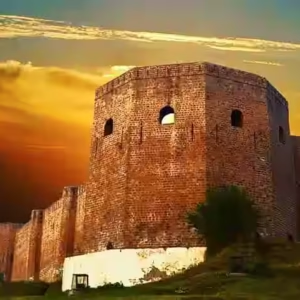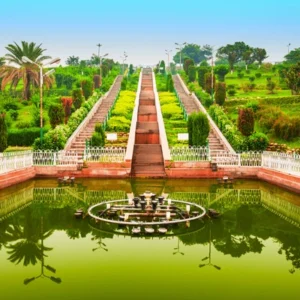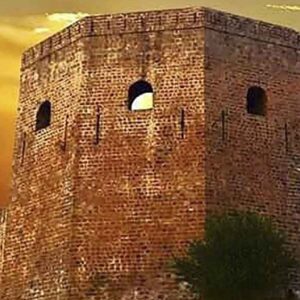Introduction
located on the peaceful banks of the Tawi River, surrounded by the awe-inspiring Shivalik hills, Bahu Fort and Bagh-e-Bahu Garden are two of Jammu’s most iconic experiences. These are more than just tourist attractions; these places embody the perfect marriage of history, spirituality, architecture, and nature. If you’re a history lover fascinated by centuries-old buildings, a nature lover searching for enchanting green spaces, or a traveler seeking to experience the cultural life of Jammu, Bahu Fort and the Bagh-e-Bahu Garden represent the perfect overlap of peace and culture.
Bahu Fort, one of the oldest structures in the region, highlights Jammu’s rich history and architectural feat. Believed to have been constructed over three thousand years ago and reconstructed multiple times by the Dogra Rajas, Bahu Fort also contains a sacred temple devoted to the Goddess Kali, better known as Bawe Wali Mata in the region. A short walk away is Bagh-e-Bahu Garden, a plush Mughal-style terraced garden featuring fountains, beds of flowers, and the views of Jammu City.
In this comprehensive piece, brought to you by Travelogear Holidays, we’ll take you on an exploration of the ultimate charm of Bahu Fort and Bagh-e-Bahu Garden. From history and architectural elements to travel tips and nearby attractions, here



About Bahu Fort – A Glimpse into Jammu’s Glorious Past
Situated on a steep hill above the River Tawi, Bahu Fort is an emblem of Jammu’s rich historical legacy and geopolitical importance. It’s understood to have been initially raised over 3,000 years ago by Raja Bahulochan, assumed to be the mythical founder of Jammu, and has seen various reconstructions and expansions, notably by Jamwal kings in the 19th century.
For centuries, Bahu Fort functioned as a vital military defensive fortification and royal abode. Its height conferred the ability to watch over and protect the city from invasion, while its sturdy structure and aspects of ancient Indian military architecture are visually conveyed through walls and watchtowers.
At the heart of the fort is the famous Bawe Wali Mata Temple, revered amongst the community as Jammu’s most important spiritual site dedicated to Goddess Kali. The temple allows thousands of patrons to receive the blessings of Maa Kali and is an influential component of Jammu’s spiritual culture especially during Navratri.
History and Significance of Bahu Fort
The origin of Bahu Fort is rooted in the history of Jammu itself, reportedly as far back as the 9th century. Legend says that Raja Bahulochan was hunting nearby at the Tawi River, when he witnessed a lion drinking peacefully with a goat by the water. Infatuated with the sacredness of the land, he proposed to develop his capital there and constructed the fort to protect it.
The fort has witnessed many invasions and strifes for supremacy in power over the centuries. The Dogra rulers also certainly restored and expanded what is now know as Bahu Fort during the 18th and 19th centuries, expanding the fort with new walls, bastions, and an iconic temple. Bahu Fort during the Dogra reign became a famous symbol of strength, sovereignty, and devotion.
Even today, Bahu Fort stands as a testament to the history of Jammu and serves as a link between its history and present.
Architecture and Layout of Bahu Fort
The Bahu Fort has an interesting architectural style, which is a deliberate combination of ancient Indian military-style architectural elements with later Dogra elements. Although the original structure has been reconstructed many times, the original elements have remained relatively intact, highlighting changes in the construction of forts over time.
Architectural Characteristics:
- Imposing Fortifications: The fort is surrounded by thick sandstone walls featuring bastions which would withstand invasion and artillery.
- Locational Strategicality: The fort is located on a very high plateau without obstruction that enabled complete surveillability of the Tawi River and valley below.
- Archway Entrances: The fort features grand entrances with intricate wood and ironwork, which are a distinctive technique of Dogra craftsmanship.
- Temple Complex: The Bawe Wali Mata Temple is within the fort courtyard, which contains sculptures and devotional art.
- Watch towers and Courtyards: space for monitoring soldiers/sentries, unsheltered platforms that are heighted for soldiers/sentries to monitor.
The views from the fort itself are breathtaking and provide panoramic views of Jammu city, the winding Tawi River and the distant Pir Panjal range.
Bawe Wali Mata Temple – The Spiritual Heart of Bahu Fort
The Bawe Wali Mata Temple, dedicated to Goddess Kali and known as the ferocious form of Shakti, is one of the main attractions of Bahu Fort. Local people come to the temple, as they believe the goddess will satisfy their requests, making it one of the most important temples in this region of Jammu.
Importantly Religious:
- Regular Ritual: Devotees visit the temple daily to pray and bring flowers and sweet meals for the goddess.
- Navratri: Every nine days of Navratri, thousands of pilgrims will arrive at the temple for special pujas, and many will stay for longer periods.
- Locals believe that if they pray at this temple before commencing any new venture, they will be successful and protected while performing it.
The temple is not merely a place of worship but also a cultural site that reflects centuries of practices that shape and demonstrate the spiritual devotion of Jammu.
Bagh-e-Bahu Garden – A Green Haven Beside the Fort
Located just beneath Bahu Fort, Bagh-e-Bahu (Garden of Bahu) is a lovely public park and one of Jammu’s most beautiful. The park is built in the Mughal style of a traditional garden: terraced lawns, decorated with flower-beds, shaded walkways, and fountains in which water cascades down.
It provides a tranquil setting from Bahu Fort and the intensity of the city.
Things to Visit In Bagh-e-Bahu Garden:
- Panoramic Views: The garden features a beautiful view of the Tawi River and overlooks Jammu city. It is a favorite place to take pictures.
- Fountains and Water channels: The garden contains fountains, inspired by Persian and Mughal landscapes.
- Seasonal floral display: Throughout the year, seasonal flowers are planted for character and perfume.
- Picnics: No surprise families and couples alike frequent this park for a picnic setting.
- Aquarium: Adjacent to the garden is Bahu Aquarium (the largest aquarium in North India)—it contains various aquatic species that children enjoy checking out.
Everyone has their reasons for visiting the garden; for you, walking leisurely, taking pictures of the surroundings, and relaxing in the park embrace peace, nature and beauty. Bagh-e-Bahu is an essential stop as part of your journey to Jammu!
Best Time to Visit Bahu Fort and Bagh-e-Bahu Garden
Both locations are open for visitors year-round, but they can be exceptionally beautiful any time of the year depending on the season.
- Spring (March to May): the most comfortable season when the flowers are blooming and the skies are clear.
- Monsoon (July to September): the landscape surrounding the sites is green and vibrant but may be rainy at times.
- Winter (October to February): has crisp air and viewing conditions are most clear, making it a prime time to visit for sightseeing and photography.
Pro Tip: Plan to visit in the early morning or late afternoon to enjoy great lighting, comfortable temperatures, and to avoid crowds.
How to Reach Bahu Fort and Bagh-e-Bahu Garden
Both are centrally situated in Jammu, only several kilometers away from the city center of Jammu.
By Air:
Jammu Airport (Satwari Airport) – ~ 8 km from Bahu Fort
There are regular flights from White Delhi, Mumbai, Chandigarh, and other major cities.
By Train:
Jammu Tawi Railway Station – ~ 5 km away.
availability of taxis and auto rickshaws.
By Road:
National Highways and Bus Service: Jammu is a well connected city through National Highway and you can choose to hire a taxi/cab, or take local transport to arrive to the site.
Entry Fees and Timings
Bahu Fort: Open from 5:00 AM to 8:00 PM (no entry fee).
Bagh-e-Bahu Garden: Open from 6:00 AM to 8:00 PM (minor entry fee).
Aquarium: Generally open from 9:00 AM to 7:00 PM (separate ticket).
Things to Do at Bahu Fort & Bagh-e-Bahu Garden
You can squeeze a thrilling visit to this major landmark if you plan it well. Here are some of the activities you should do:
- Explore the Fort: Walk along the old walls, gates and watchtowers to beat the heart of the period.
- Get Blessings: Visit the temple called Bawe Wali Mata and take part in daily rituals.
- Views: Get panoramic shots of Jammu city and the Tawi river from the fort.
- Relax in the Garden: Walk through the landscaped lawns and sit by the fountains.
- Aquarium: Explore the area both educational and fun. Learn about marine, brackish, and freshwater life.
- Photography: Capture amazing architecture & landscape & sunset.
Nearby Attractions
Make sure to group your trip together with additional places that you cannot miss when in Jammu.
– Raghunath Temple, which is one of the largest temple complexes in North India;
– Mubarak Mandi Palace, a historical Dogra-era palace;
– Ranbireshwar Temple, famed for its enormous Shivalingas;
– Peer Kho Cave Temple, which is an important cave shrine dedicated to Lord Shiva;
– Amar Mahal Palace is a French-style palace and museum, which highlights Dogra history.
Travel Tips for Visitors
- Come on a weekday to avoid crowds.
- Wear comfortable shoes. There is quite a lot of walking and climbing.
- Bring water, sunscreen, and a hat, particularly in the hotter months.
- Morning visits provide comfortable weather, and wonderful photo opportunities.
- Be respectful of local customs, particularly within the temple grounds.
Why Visit with Travelogear Holidays
Seeing Bahu Fort and Bagh-e-Bahu Garden is not just a sightseeing trip; it’s a full immersion into culture, spirituality, and heritage in Jammu. With Travelogear Holidays, it is easy to enjoy this journey! Our Jammu heritage tours provide guided excursions, embedded culture, good transport and planning — all you have to do is focus on enjoying the experience and creating unforgettable memories!
Conclusion
Bahu Fort and Bagh-e-Bahu Garden are not only historical sites, but also living representations of Jammu’s past, present and spirit. From the proud stone walls of the ancient fort and the serenity of the Bawe Wali Mata Temple to the peaceful charm of the Mughal-design gardens, everything that takes place on this site brings you closer to the heart of the city.
First time in Jammu or coming back to see if you missed anything, these two must-do’s should be on your trip list. When you go see these two stops with Travelogear Holidays, your travel will be comfortable, enlightening and absolutely memorable.
Top 10 FAQs About Bahu Fort & Bagh-e-Bahu Garden
1. Who built Bahu Fort in Jammu?
Bahu Fort was originally built over 3,000 years ago by Raja Bahulochan, the founder of Jammu.
2. What is Bahu Fort famous for?
It is known for its ancient history, strategic location, and the revered Bawe Wali Mata Temple inside.
3. Where is Bagh-e-Bahu Garden located?
It is located just below Bahu Fort on the banks of the Tawi River in Jammu city.
4. What is the best time to visit Bahu Fort?
Spring (March–May) and winter (October–February) are ideal for pleasant weather and clear views.
5. Is there an entry fee for Bahu Fort?
No, entry to Bahu Fort is free, though Bagh-e-Bahu Garden and Aquarium may charge a small fee.
6. Are there any temples inside Bahu Fort?
Yes, the Bawe Wali Mata Temple dedicated to Goddess Kali is inside the fort.
7. How much time is needed to explore the site?
Around 2–3 hours is sufficient to explore both the fort and garden comfortably.
8. Is photography allowed?
Yes, photography is allowed in most areas, especially the gardens and exterior of the fort.
9. Can we visit Bahu Fort in the evening?
Yes, the fort and garden are open until evening, and the sunset views are spectacular.
10. Are guided tours available?
Yes, guided tours are available through local operators like Travelogear Holidays for a richer experience.
How to book Bahu Fort Tour Packages With Travelogear Holidays?
For a seamless and exceptional booking experience,
Contact Travelogear Holidays at: reservationtravelogearholidays@gmail.com or call us at : 9906903196

